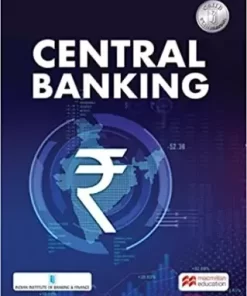- Binding : Softcover
- Publisher: Taxmann Publications Pvt. Ltd
- Author : Indian Institute of Banking & Finance (IIBF)
- Edition : October 2024
- Language: English
- ISBN-10 : 9789357788571
- ISBN-13 : 9789357788571
Taxmann’s IT Security by Indian Institute of Banking & Finance (IIBF)
₹435.00
Taxmann’s IT Security by Indian Institute of Banking & Finance (IIBF). This book provides an in-depth analysis of IT security tailored specifically for the banking sector. The key features include a thorough understanding of foundational principles like confidentiality, integrity, and availability and practical guidance on implementing robust security controls for hardware, software, and network systems. It also addresses modern cybersecurity challenges such as malware, data breaches, and incident management, providing strategies to mitigate risks and ensure business continuity. Additionally, the book emphasises regulatory compliance, covering standards set by RBI, SEBI, and TRAI, along with detailed audit methodologies.
10 in stock
Taxmann’s IT Security by Indian Institute of Banking & Finance (IIBF).
Taxmann’s IT Security by Indian Institute of Banking & Finance (IIBF).
Description :-
This book discusses the critical role of IT security within the banking sector, highlighting the need to protect physical and digital assets from the increasing threats of cyberattacks. With rapid advancements in digital finance, the book emphasises the necessity for professionals to understand IT security’s foundational principles, from managing risk to implementing secure infrastructures.
It is designed specifically for the banking sector; this book provides an in-depth examination of the essential elements of IT security and serves as a guide for professionals aiming to enhance the security of their institutions. This book benefits IT professionals, bankers, and students pursuing certification in IT security, equipping them with practical knowledge of security controls, threat management, and regulatory compliance.
The Present Publication is the 2024 Edition, revised and updated by Dr Pradeep Kumar | Professor of Information Technology and Systems – IIM Lucknow, and vetted by Dr Deepak Kumar Tomar | Professor and HoD, Computer Science & Engineering Department – MANIT Bhopal. Taxmann exclusively publishes this book for the Indian Institute of Banking and Finance with the following noteworthy features:
- [Understanding IT Security in Banking] The book provides an essential introduction to the fundamentals of IT security, focusing on the critical role it plays in safeguarding banks’ infrastructures. It covers the key objectives of information security—confidentiality, integrity, and availability—along with the importance of secure IT governance and compliance with industry standards
- [Implementation of Security Controls] The book discusses the practical application of IT security controls, including securing hardware, software, and network systems within banks. It emphasises the importance of physical and environmental controls and the management of software development processes to ensure a robust security posture. With real-world examples, the book illustrates how these controls mitigate threats and ensure system resilience
- [Addressing IT Security Threats] This book discusses modern cybersecurity challenges, such as malware, viruses, and data breaches, providing strategies for preventing and managing these risks. It covers fault-tolerant systems, incident management, and business continuity to ensure minimal downtime during an attack. The book also discusses the evolving nature of security threats, preparing professionals to stay ahead of emerging risks
- [IS Audit and Regulatory Compliance] The book thoroughly examines the role of audits in ensuring IT security compliance with regulatory standards, particularly those set by the Reserve Bank of India (RBI) and other Indian authorities like SEBI and TRAI. It provides an in-depth look at audit methodologies and regulatory mechanisms, equipping readers with the tools needed to ensure their institutions meet legal and security standards
The book adopts a modular approach, ensuring a coherent and logical flow of content across its four modules, which are as follows:
- Module A – IT Security Overview
- Introduction to Information Security – This unit provides a comprehensive introduction to information security, focusing on the objectives and essential attributes of securing data within banking infrastructures. It discusses both physical and logical security measures and offers insights into organisational security goals
- Corporate IT Security Policies – This chapter covers the creation and implementation of corporate security policies, discussing their legal requirements and the need for awareness initiatives to ensure proper security measures are in place
- Organisational Security and Risk Management – Focuses on risk metrics, security governance, and frameworks for managing security threats in public sector organisations and banks
- Hardware and Software Security – Discusses how to secure network devices, cloud computing systems, and operational software in the banking, telecom, and IT industries. It emphasises the importance of protecting both hardware and software assets
- Security Standards and Best Practices – Covers international standards such as ISO 27001 and COBIT, providing readers with globally recognised best practices for managing IT security in banking
- Module B – IT Security Controls
- Asset Classification and Controls – Focuses on classifying and securing information assets and managing traditional and digital security systems, including OSI models and information management security
- Network Controls – Discusses controls used in layered networks, including VLANs, firewalls, and intrusion detection systems (IDS). It explores the benefits of unified threat management (UTM) in securing banking networks
- Controls in Software Development – Covers secure development processes, cloud computing, and big data controls, ensuring that banking systems are safe from development through to maintenance
- Module C – IT Security Threats
- Overview of Security Threats – Explores the diverse range of security threats banks face, including cyber espionage, cyber terrorism, and hacking attempts
- Prevention of Software Attacks – Offers strategies to mitigate software-related attacks, covering malware, viruses, and various controls to protect banking systems
- Incident Management and Business Continuity – Focuses on managing incidents effectively to minimise damage and downtime. It also provides guidelines for ensuring business continuity and disaster recovery
- Module D – IS Audit and Regulatory Compliance
- Information Systems Audit – Introduces the history and methodologies of IS audits, covering planning, execution, and reporting for both internal and external audits in banking systems
- Regulatory Mechanisms in Indian Banks – Details the regulatory standards enforced by the RBI, including compliance measures and initiatives like the Gopalakrishna Working Group, ensuring that banks maintain legal and security standards.
Indian Institute of Banking & Finance
Established in 1928 as a Company under Section 25 of the Indian Companies Act, 1913, the Indian Institute of Banking & Finance (IIBF), formerly known as The Indian Institute of Bankers (IIB), is a professional body of Banks, Financial Institutions, and their employees in India.
The Institute is managed by a Governing Council consisting of representatives of major Banks, Reserve Bank of India, Indian Banks’ Association, Institute of Banking Personnel Selection and an academician from the Indian Institute of Technology, Bombay.
During its 93 years of service, IIBF has emerged as a premier institute in Banking and Finance education for those employed as well as seeking employment in the sector and aiming for professional excellence. Since its inception, the Institute has awarded several Banking and Finance qualifications, viz., JAIIB, CAIIB, Diploma and Certificates, covering diverse and contemporary subjects in the Banking & Finance domains. Moreover, IIBF is the only Institute that offers all the courses mandated by the Reserve Bank of India for capacity building in banks. In addition, the contemporary courses and training programmes have helped the industry professionals to sustain their professionalism through Continuing Professional Development Programmes.
IIBF offers a bouquet of courses on Banking & Finance to meet the needs and aspirations of the banking & finance personnel and to students aspiring for a career in the banking & finance sector.












Reviews
There are no reviews yet.